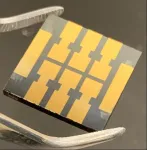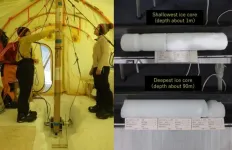(Press-News.org) PROVIDENCE, R.I. [Brown University] -- A research team from Brown University has made a major step toward improving the long-term reliability of perovskite solar cells, an emerging clean energy technology. In a study to be published on Friday, May 7 in the journal Science, the team demonstrates a "molecular glue" that keeps a key interface inside cells from degrading. The treatment dramatically increases cells' stability and reliability over time, while also improving the efficiency with which they convert sunlight into electricity.
"There have been great strides in increasing the power-conversion efficiency of perovskite solar cells," said Nitin Padture, a professor of engineering at Brown University and senior author of the new research. "But the final hurdle to be cleared before the technology can be widely available is reliability -- making cells that maintain their performance over time. That's one of the things my research group has been working on, and we're happy to report some important progress."
Perovskites are a class of materials with a particular crystalline atomic structure. A little over a decade ago, researchers showed that perovskites are very good at absorbing light, which set off a flood of new research into perovskite solar cells. The efficiency of those cells has increased quickly and now rivals that of traditional silicon cells. The difference is that perovskite light absorbers can be made at near room temperature, whereas silicon needs to be grown from a melt at a temperature approaching 2,700 degrees Fahrenheit. Perovskite films are also about 400 times thinner than silicon wafers. The relative ease of the manufacturing processes and the use of less material means perovskite cells can be potentially made at a fraction of the cost of silicon cells.
While the efficiency improvements in perovskites have been remarkable, Padture says, making the cells more stable and reliable has remained challenging. Part of the problem has to do with the layering required to make a functioning cell. Each cell contains five or more distinct layers, each performing a different function in the electricity-generation process. Since these layers are made from different materials, they respond differently to external forces. Also, temperature changes that occur during the manufacturing process and during service can cause some layers to expand or contract more than others. That creates mechanical stresses at the layer interfaces that can cause the layers to decouple. If the interfaces are compromised, the performance of the cell plummets.
The weakest of those interfaces is the one between the perovskite film used to absorb light and the electron transport layer, which keeps current flowing through the cell.
"A chain is only as strong as its weakest link, and we identified this interface as the weakest part of the whole stack, where failure is most likely," said Padture, who directs the Institute for Molecular and Nanoscale Innovation at Brown. "If we can strengthen that, then we can start making real improvements in reliability."
To do that, Padture drew on his experience as a material scientist, developing advanced ceramic coatings used in aircraft engines and other high-performance applications. He and his colleagues began experimenting with compounds known as self-assembled monolayers or SAMs.
"This is a large class of compounds," Padture said. "When you deposit these on a surface, the molecules assemble themselves in a single layer and stand up like short hairs. By using the right formulation, you can form strong bonds between these compounds and all kinds of different surfaces."
Padture and his team found that a formulation of SAM with silicon atom on one side, and iodine atom on the other, could form strong bonds with both the election transport layer (which is usually made of tin oxide) and the perovskite light-absorbing layer. The team hoped that the bonds formed by these molecules might fortify the layer interface. And they were right.
"When we introduced the SAMs to the interface, we found that it increases the fracture toughness of the interface by about 50%, meaning that any cracks that form at the interface tend not to propagate very far," Padture said. "So in effect, the SAMs become a kind of molecular glue that holds the two layers together."
Testing of solar cell function showed that the SAMs dramatically increased the functional life of the perovskite cells. Non-SAM cells prepared for the study retained 80% of its initial efficiency for around 700 hours of lab testing. Meanwhile the SAM cells were still going strong after 1,330 hours of testing. Based on these experiments, the researchers project the 80%-retained-efficiency life to be about 4,000 hours.
"One of the other things we did, which people don't normally do, is we broke open the cells after testing," said Zhenghong Dai, a Brown doctoral student and first author of the research. "In the control cells without the SAMs, we saw all kinds of damage such as voids and cracks. But with the SAMs, the toughened interfaces looked really good. It was a dramatic improvement that really kind of shocked us."
Importantly, Padture said, the improvement in toughness did not come at the cost of power-conversion efficiency. In fact, the SAMs actually improved the cell's efficiency by a small amount. That occurred because the SAMs eliminated tiny molecular defects that form when the two layers bond in the absence of SAMs.
"The first rule in improving the mechanical integrity of functional devices is 'do no harm,'" Padture said. "So that we could improve reliability without losing efficiency -- and even improving efficiency -- was a nice surprise."
The SAMs themselves are made from readily available compounds and are easily applied with a dip-coating process at room temperature. So the addition of SAMs would potentially add little to the production cost, Padture said.
The researchers plan to build on this success. Now that they've fortified the weakest link in the perovskite solar cell stack, they'd like to move onto the next weakest, then the next and so on until they've fortified the entire stack. That work will involve strengthening not only the interfaces, but also the material layers themselves. Recently, Padture's research group won a $1.5 million grant from the U.S. Department of Energy to expand on their research.
"This is the kind of research that's required in order to make cells that are inexpensive, efficient and perform well for decades," Padture said.
INFORMATION:
Srinivas K. Yadavalli, Min Chen, Ali Abbaspourtamijani and Yue Qi were co-authors of the research, which was funded by the Office of Naval Research (N00014-17-1-2232 and N00014-20-1-2574) and the National Science Foundation (1538893 and 2002158).
MUSC Hollings Cancer Center researchers added to the understanding of the protective immune response against the SARS-CoV-2 virus in a study published in April in iScience. The team found that approximately 3% of the population is asymptomatic, which means that their bodies can get rid of the virus without developing signs of illness.
The researchers screened more than 60,000 blood samples from symptomless individuals in the Southeastern U.S., including Georgia, South Carolina and North Carolina, for the IgG antibody to the viral spike protein.
What began as a highly collaborative statewide effort to detect SARS-CoV-2 accurately, ...
Recently published research from the University of Arizona Health Sciences shows that advanced-stage kidney cancer is more common in Hispanic Americans and Native Americans than in non-Hispanic whites, and that both Hispanic Americans and Native Americans in Arizona have an increased risk of mortality from the disease.
"We knew from our past research that Hispanic Americans and Native Americans have a heavier burden of kidney cancer than non-Hispanic whites," said Ken Batai, PhD, a Cancer Prevention and Control Program research member at the UArizona Cancer Center and research assistant professor of urology in the College of Medicine - Tucson. "But we also know that around 90% of the Hispanic population in Arizona is Mexican American - either U.S.-born or Mexican-born ...
The air in the United States and Western Europe is much cleaner than even a decade ago. Low-sulfur gasoline standards and regulations on power plants have successfully cut sulfate concentrations in the air, reducing the fine particulate matter that harms human health and cleaning up the environmental hazard of acid rain.
Despite these successes, sulfate levels in the atmosphere have declined more slowly than sulfur dioxide emissions, especially in wintertime. This unexpected phenomenon suggests sulfur dioxide emission reductions are less efficient than expected for cutting sulfate aerosols. A new study led by Tokyo Institute of Technology (Tokyo Tech), Hokkaido University and the University ...
The ability of antibodies to recognize specific cancer cells is used in oncology to specifically target those cells with small active agents. Research published in the journal Angewandte Chemie shows that scientists have now built a transport system that delivers even large protein-based drugs into cancer cells. This study demonstrates how proteins can arrive at their target intact, protected from destructive proteases by polymer brushes.
Developing anticancer treatments involves two recurring problems for researchers. An active agent needs to be able to kill the body's cells at the root of the cancer, and it should be active in target cancer cells rather than in healthy cells. Many medical researchers ...
When you save an image to your smartphone, those data are written onto tiny transistors that are electrically switched on or off in a pattern of "bits" to represent and encode that image. Most transistors today are made from silicon, an element that scientists have managed to switch at ever-smaller scales, enabling billions of bits, and therefore large libraries of images and other files, to be packed onto a single memory chip.
But growing demand for data, and the means to store them, is driving scientists to search beyond silicon for materials that can push memory devices to higher densities, ...
For millennia, humans in the high latitudes have been enthralled by auroras--the northern and southern lights. Yet even after all that time, it appears the ethereal, dancing ribbons of light above Earth still hold some secrets.
In a new study, physicists led by the University of Iowa report a new feature to Earth's atmospheric light show. Examining video taken nearly two decades ago, the researchers describe multiple instances where a section of the diffuse aurora--the faint, background-like glow accompanying the more vivid light commonly associated with auroras--goes dark, as if scrubbed by a giant blotter. Then, after a short period of time, the blacked-out section suddenly reappears.
The researchers say the behavior, which they call "diffuse ...
New research published in Experimental Physiology highlight the possible long term health impacts of COVID-19 on young, relatively healthy adults who were not hospitalized and who only had minor symptoms due to the virus.
Increased stiffness of arteries in particular was found in young adults, which may impact heart health, and can also be important for other populations who may have had severe cases of the virus. This means that young, healthy adults with mild COVID-19 symptoms may increase their risk of cardiovascular complications which may continue for some time after COVID-19 infection.
While SARS-CoV-2, the virus known ...
Just as people keep their houses clean and clutter under control, a crew of cells in the body is in charge of clearing the waste the body generates, including dying cells. The housekeeping cells remove unwanted material by a process called phagocytosis, which literally means 'eating cells.' The housekeepers engulf and ingest the dying cells and break them down to effectively eliminate them.
"Phagocytosis is very important for the body's health," said Dr. Zheng Zhou, whose lab at Baylor College of Medicine has been studying phagocytosis for many years and provided key new insights into this essential process. "When this cell-eat-cell process fails, the dying cells will lose their integrity, break down and release their content into the surrounding tissues. Dumping the ...
St. Jude Children's Research Hospital scientists have developed an integrated, high-throughput system to better understand and possibly manipulate gene expression for treatment of disorders such as sickle cell disease and beta thalassemia. The research appears today in the journal Nature Genetics.
Researchers used the system to identify dozens of DNA regulatory elements that act together to orchestrate the switch from fetal to adult hemoglobin expression. The method can also be used to study other diseases that involve gene regulation.
Regulatory elements, also called genetic switches, are scattered throughout non-coding regions of DNA. ...
Retinoblastoma starts in the retina, the thin membrane at the back of the eye. Most patients are infants or toddlers when their cancer is found. Without treatment, the cancer spreads. Thanks to chemotherapy, surgery and other treatments, 96% of patients survive.
St. Jude researchers studied how survivors fared years later at home and at school. A previous St. Jude study of 98 retinoblastoma survivors found that their early learning and life skills declined from diagnosis to age 5.
Researchers tested 78 of the same survivors five years later. The results were more upbeat. By age 10, almost all the children functioned within the normal range ...




